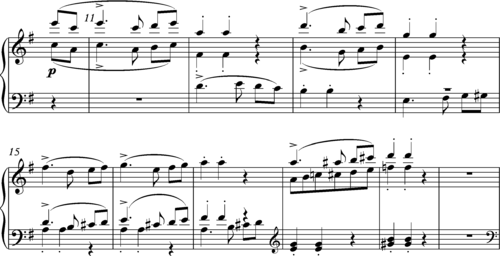Texture (music)
In
Common types
In musical terms, particularly in the fields of music history and music analysis, some common terms for different types of texture are:
| Type | Description | Visual | Audio | |
|---|---|---|---|---|
| Monophonic | Monophonic texture includes a single melodic line with no accompaniment.[4] PSMs often double or parallel the PM they support.[5] |  |
||
| Biphonic | Two distinct lines, the lower sustaining a drone (constant pitch) while the other line creates a more elaborate melody above it. ostinati would be an example of a SS.[5] It is generally considered to be a type of polyphony.
|
 |
||
Contrapuntal
|
Multiple melodic voices which are to a considerable extent independent from or in imitation with one another. Characteristic texture of the Renaissance music, also prevalent during the Baroque period.[8] Polyphonic textures may contain several PMs.[5] |  |
||
| Homophonic | The most common texture in Western music: melody and accompaniment. Multiple voices of which one, the melody, stands out prominently and the others form a background of harmonic accompaniment. If all the parts have much the same rhythm, the homophonic texture can also be described as homorhythmic. Characteristic texture of the Classical period and continued to predominate in Romantic music while in the 20th century, "popular music is nearly all homophonic," and, "much of jazz is also" though, "the simultaneous improvisations of some jazz musicians creates a true polyphony".[4] Homophonic textures usually contain only one PM.[5] HS and RS are often combined, thus labeled HRS.[5] | If Ye Love Me", composed in 1549. The voices move together using the same rhythm, and the relationship between them creates chords: the excerpt begins and ends with an F major triad . |
||
| Homorhythmic | Multiple voices with similar rhythmic material in all parts. Also known as "chordal". May be considered a condition of homophony or distinguished from it. | see above | ||
| Heterophonic | Two or more voices simultaneously performing variations of the same melody. | |||
| Silence | No sound at all or the absence of intended sound |
Many classical pieces feature different kinds of texture within a short space of time. An example is the Scherzo from Schubert’s piano sonata in B major, D575. The first four bars are monophonic, with both hands performing the same melody an octave apart:

Bars 5–10 are homophonic, with all voices coinciding rhythmically:

Bars 11–20 are

After the silence, the polyphonic texture expands from three to four independent parts moving simultaneously in bars 21–24. The upper two parts are imitative, the lowest part consists of a repeated note (pedal point) and the remaining part weaves an independent melodic line:

The final four bars revert to homophony, bringing the section to a close;

A complete performance can be heard by following this link: Listen
Additional types
Although in music instruction certain styles or repertoires of music are often identified with one of these descriptions this is basically added music[clarification needed] (for example, Gregorian chant is described as monophonic, Bach Chorales are described as homophonic and fugues as polyphonic), many composers use more than one type of texture in the same piece of music.
A simultaneity is more than one complete musical texture occurring at the same time, rather than in succession.
A more recent type of texture first used by
See also
References
- ^ Benward & Saker 2003, p. 133.
- ^ Benward & Saker 2003, [page needed].
- ^ Isaac & Russell 2003, p. 136.
- ^ a b Benward & Saker 2003, p. 136.
- ^ a b c d e Benward & Saker 2003, p. 137.
- ^ Kliewer 1975, pp. 270–301.
- ^ Benward & Saker 2003, p. 99.
- ^ Benward & Saker 2003, p. [page needed].
- ^ Corozine 2002, p. 34.
Sources
- Benward, Bruce, and Marilyn Nadine Saker (2003). Music: In Theory and Practice, seventh edition, vol. 1. Boston: McGraw-Hill. ISBN 978-0-07-294262-0.
- Corozine, Vince (2002). Arranging Music for the Real World: Classical and Commercial Aspects. Pacific, Missouri: Mel Bay. OCLC 50470629.
- Kliewer, Vernon (1975). "Melody: Linear Aspects of Twentieth-Century Music". In Aspects of Twentieth-Century Music, edited by Gary Wittlich, pp. 270–301. Englewood Cliffs, New Jersey: Prentice-Hall. ISBN 0-13-049346-5.
Further reading
- Anon.: "Monophony", Grove Music Online, edited by Deane L. Root (subscription required).
- Copland, Aaron. (1957). What to Listen for in Music, revised edition. New York: McGraw-Hill
- Demuth, Norman. 1964. Musical Forms and Textures: A Reference Guide, second edition. London: Barrie and Rockliff.
- Frobenius, Wolf, Peter Cooke, Caroline Bithell, and Izaly Zemtsovsky: "Polyphony", Grove Music Online. edited by Deane Root (subscription required).
- ISBN 0-393-97168-6.
- Hyer, Brian: "Homophony", Grove Music Online, edited by Deane Root (subscription required).
- Keys, Ivor. 1961. The Texture of Music: From Purcell to Brahms. London: D. Dobson.
- Kokoras, Panayiotis (2005). Towards a Holophonic Musical Texture. In Proceedings of the ICMC2005 – International Computer Music Conference,[page needed]. Barcelona: International Computer Music Conference.
- White, John David. 1995. Theories of Musical Texture in Western History. Perspectives in Music Criticism and Theory 1; Garland Reference Library of the Humanities 1678. New York: Garland Publishers.
